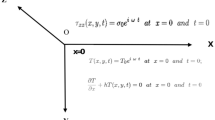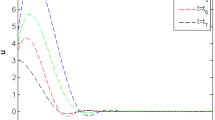Abstract
A mathematical model for a three dimensional isotropic half-space has been formulated to inspect lagging behaviours due to the presence of phase lags in context of memory dependent derivative, as an extension of several existing thermoelastic models like- Green-Naghdi-III, Lord Shulman, and Fourier’s Law etc. The analytical and procedural work has been done in integral transform domain preceded by eigenvalue approach to find the solution from the governing equations. Numerical computations and graphical representation of distribution of non-dimensional stress components, temperature with the effect of three phase lag, kernel function and time-delay has been performed with the help of the efficient mathematical software.













Similar content being viewed by others
Abbreviations
- x i :
-
Space variables
- \( \lambda ,\mu \) :
-
Lame’s Constant
- u i :
-
Displacement components
- \( \tau \) :
-
Relaxation Time
- \( C_{E} \) :
-
Specific heat at constant strain
- \( \tau_{q} \,,\tau_{v} \,,\tau_{T} \) :
-
Three-phase-lag
- t :
-
Time variable
- \( \rho \) :
-
Density of the material
- \( T_{0} \) :
-
Reference temperature chosen such that \( \left| {\frac{{T - T_{0} }}{{T_{0} }}} \right| \) ≪ 1
- \( \varepsilon = \tfrac{{\gamma^{2} T_{0} }}{{\rho C_{E} (\lambda + 2\mu )}} \) :
-
Thermal coupling parameter
- σ ij :
-
Stress Components
- ω :
-
Time delay
- K (t, ξ):
-
Kernel function
References
Biot, M.A.: Thermoelasticity and irreversible thermodynamics. J. Appl. Phys. 27(3), 240–253 (1956)
Hetnarski, R.B., Ignaczak, J.: Generalized thermoelasticity. J. Therm. Stress. 22(4), 451–476 (1999)
Lord, H.W., Shulman, Y.: A generalized dynamical theory of thermoelasticity. J. Mech. Phys. Solids 15(5), 299–309 (1967)
Ranjit, S.D., Sherief, H.H.: Generalized thermoelasticity for anisotropic media. Q. Appl. Math. 33(1), 1–8 (1980)
Sherief, H.H., Anwar, MdN: Problem in generalized thermoelasticity. J. Therm. Stress 9(2), 165–181 (1986)
Ozisik, M.N., Tzou, D.Y.: On the wave theory in heat conduction. ASME J. Heat Transf. 116(3), 526–535 (1994)
Green, A.E., Lindsay, K.A.: Thermoelasticity. J. Elast. 2(1), 1–7 (1972)
Hetnarski, R.B., Ignaczak, J.: Soliton-like waves in a low temperature nonlinear thermoelastic solid. Int. J. Eng. Sci. 34(15), 1767–1787 (1996)
Kosinski, W., Cimmelli, V.A.: Gradient generalization to inertial state variables and a theory of super fluidity. J. Theor. Appl. Mech. 35, 763–779 (1997)
Green, A.E., Naghdi, P.M.: A re-examination of the basic postulates of thermomechanics. Proc. R. Soc. Lond. Ser. A (1991). https://doi.org/10.1098/rspa.1991.0012
Green, A.E., Naghdi, P.M.: On undamped heat waves in an elastic solid. J. Ther. Stress. 15(2), 253–264 (1992)
Green, A.E., Naghdi, P.M.: Thermoelasticity without energy dissipation. J. Elast. 31(3), 189–208 (1993)
Chandrasekhariah, D.S.: Hyperbolic thermoelasticity: a review of recent literature. Appl. Mech. Rev. 21(12), 705–729 (1998)
Tzou, D.Y.: A unified field approach for heat conduction from macro- to micro-scales. J. Heat Transf. 117(1), 8–16 (1995)
Tzou, D.Y.: Experimental support for the lagging behavior in heat propagation. J. Thermophys. Heat Transf. 9(4), 686–693 (1995)
Roy Choudhuri, S.K.: On a thermoelastic three-phase-lag model. J. Therm. Stress. 30(3), 231–238 (2007)
Wang, J.L., Li, H.F.: Surpassing the fractional derivative: concept of the memory-dependent derivative. Comput. Math Appl. 62, 1562–1567 (2011)
Ghosh, D., Lahiri, A.: A Study on the generalized thermoelastic problem for an anisotropic medium. J. Heat Transf. 140(9), 094501 (2018)
Belman, R., Kalaba, R.E., Lockett, J.: Numerical inversion of the laplace transform. American Elsevier, New York (1956)
McPhedran, R.C., McKenzie, D.R.: The Conductivity of Lattices of Spheres I. The Simple Cubic Lattice. Royal Sciety Publishing, London (1978)
Sclater, J.G., Parsons, B., Jaupart, C.: Oceans and continents similarities and differences in the mechanisms of heat loss. J. Geophys. Res. 86, 11535–11552 (1981)
Turcotte, D.L., Schubert, G.: Geodynamics–applications of continuum physics to geological problems. Wiley, New York (1982)
Ezzat, M.A., El Karamany, A.S., Fayik, M.A.: Fractional order theory in thermoelastic solid with three-phase lag heat transfer. Arch. Appl. Mech. 82(4), 557–572 (2012)
Sarkar, N., Mondal, S.: Transient responses in a two-temperature thermoelastic infinite medium having cylindrical cavity due to moving heat source with memory-dependent derivative. J. Appl. Math. Mech. 99(6), e201800343 (2019)
Abbas, I.A.: A GN model based upon two-temperature generalized thermoelastic theory in an unbounded medium with a spherical cavity. Appl. Math. Comput. 245, 108–115 (2014)
Atwa, S.Y., Sarkar, N.: Memory-dependent magneto–thermoelasticity for perfectly conducting two-dimensional elastic solids with thermal shock. J. Ocean Eng. Sci. (2019). https://doi.org/10.1016/j.joes.2019.05.004
Lofty, K., Sarkar, N.: Memory-dependent derivatives for photothermal semiconducting medium in generalized thermoelasticity with two-temperature. Mech. Time Depend. Mater. 21(4), 519–534 (2017)
Abd-alla, A.N., Abbas, I.A.: A problem of generalized magnetothermoelasticity for an infinitely long, perfectly conducting cylinder. J. Therm. Stress. 25(11), 1009–1025 (2002)
Abbas, I.A.: A problem on functional graded material under fractional order theory of thermoelasticity. Theor. Appl. Fract. Mech. 74, 18–22 (2014)
Abbas, I.A., Abo-Dahad, S.M.: On the numerical solution of thermal shock problem for generalized magneto-thermoelasticity for an infinitely long annular cylinder with variable thermal conductivity. J. Comput. Theor. Nanosci. 11(3), 607–618 (2014)
Abbas, I.A., Youssef, H.M.: A nonlinear generalized thermoelasticity model of temperature-dependent materials using finite element method. Int. J. Thermophys. 33(7), 1302–1303 (2012)
Abbas, I.A., Youssef, H.M.: Two-temperature generalized thermoelasticity under ramp-type heating by finite element method. Meccanica 48(2), 331–339 (2013)
Ghosh, D., Lahiri, A., Kumar, R., Roy, S.: 3D thermoelastic interactions in an anisotropic elastic slab due to prescribed surface temperature. J. Solid Mech. 10(3), 502–521 (2018)
Author information
Authors and Affiliations
Corresponding author
Additional information
Publisher's Note
Springer Nature remains neutral with regard to jurisdictional claims in published maps and institutional affiliations.
Appendix
Appendix
\( \begin{aligned} & d_{1} = (h_{24} h_{13} - h_{14} h_{23} )(h_{22} h_{33} - h_{32} h_{23} ) - (h_{34} h_{23} - h_{24} h_{33} )(h_{12} h_{23} - h_{22} h_{13} ), \\ & d_{2} = (h_{34} h_{23} - h_{24} h_{33} )(h_{11} h_{23} - h_{21} h_{13} ) - (h_{24} h_{13} - h_{14} h_{23} )(h_{21} h_{33} - h_{31} h_{23} ), \\ & d_{3} = (h_{12} h_{21} - h_{11} h_{22} )(h_{21} h_{34} - h_{31} h_{24} ) - (h_{22} h_{31} - h_{21} h_{32} )(h_{11} h_{24} - h_{14} h_{21} ), \\ & d_{4} = (h_{11} h_{23} - h_{21} h_{13} )(h_{22} h_{33} - h_{32} h_{23} ) - (h_{12} h_{23} - h_{22} h_{13} )(h_{21} h_{33} - h_{31} h_{23} ), \\ \end{aligned} \),
Rights and permissions
About this article
Cite this article
Ghosh, D., Das, A.K. & Lahiri, A. Modelling of a Three Dimensional Thermoelastic Half Space with Three Phase Lags using Memory Dependent Derivative. Int. J. Appl. Comput. Math 5, 154 (2019). https://doi.org/10.1007/s40819-019-0731-y
Published:
DOI: https://doi.org/10.1007/s40819-019-0731-y




